Summer is here and I am looking forward to getting out to the beach to paddle, surf and swim more often! If you are like me, with sensitive skin and an affinity to play outside, it’s important to find the right non-toxic sunscreen to not damage your skin or be overly exposed to harmful ultraviolet light (UV).
Beyond summer, there is plenty of skin-damaging sunshine all year. In winter months, sun reflects off snow or tropical waters if we vacation there. Unfortunately many brands of sunscreen are toxic to our bodies and our waterways. Toxic sunscreen ingredients, like Oxybenzone, can leach off our skin in the ocean and poison coral reefs and fish.
Half the battle with non-toxic sport sunscreen is about finding one you like enough to actually use! There are so many factors to consider when choosing a sport sunscreen. It can be misleading and confusing to find clean, organic, non-toxic sunscreens that will stay on while you are playing, sweating, or swimming, without the sunscreen being a goopy white sheen, too drying, or uncomfortable. Doubt no more! I am here to make these choices easy for you.
I’ve taken some time to examine a variety of excellent products. They score low (meaning good) on Environmental Working Group’s (EWG) rating system. They also score high by picky sporty consumers like me with sensitive aging skin. I prefer a clean lightweight feel with infused vitamins and moisturizing ingredients—that are good for my skin, good for a baby, and good for the environment I play in, that won’t damage corals and fish.
Below I have listed my 5 favorite sun protection formulas made for highly active consumers. The following PacifiCurrent guideline was used to score the sport sunscreens:
PacifiCurrent’s Sport Sunscreen Guideline:
- Low EWG Rating: The following recommended sunscreens all earn low ratings (the lower the better on a scale of 1-10) from the Environmental Working Group’s Skin Deep database. They rate every ingredient for safety. However, a low rating doesn’t necessarily mean you will love the product. It could mean goopy whitecast and uncomfortable.
- Choose Non-Chemical Sunscreen: Many ingredients in sunscreens can be harmful to your body and aquatic animals. You should be wary of all chemical sunscreens. Like a catch 22—they can do more harm than good. Chemical sunscreens can employ a potent combination of chemicals like Oxybenzone, Octinoxate (Octylmethoxycinnamate), Homosalate, Octisalate, Octocrylene, and Avobenzone, many of which produce damaging free radicals in cells and are hormone and endocrine disruptors—meaning they mimic hormones and can interfere with everything from our reproductive systems to our metabolism. (See: EWG list of toxic chemicals in sunscreen.) Some of the most toxic brands include Coppertone, Banana Boat and Neutrogena.
- Red Flag Ingredients: Red flags to look for in “inactive ingredients” that are toxic include anything ending in -paraben, pthalates, sodium laureth sulfate, and fragrance. Oxybenzone is the other ingredient to look for—it’s harmful to coral reefs and fish. Oxybenzone earns an 8 from the EWG.
- Choose Non-Nano: Most nano sunscreens are grouped in the chemical sunscreen category, which can have adverse effect on your skin even if protects you from UV. Sunscreen formulas that use nano-particles, particularly of zinc oxide and titanium dioxide, can potentially increase cancer risk and promote skin aging. Micronized metal particles (nanoparticles) of titanium and zinc are so small (less than 100nm particle size) that they can penetrate bodily organs. Nano sunscreens are designed to allow your skin to absorb the sun’s rays, instead of physically blocking UVA and UVB by sitting on top of your skin. The research on these particles still remains inconclusive, but it’s important to know nanoparticles and the synergy of these particles with other chemicals haven’t been thoroughly studied. NOTE: Not all non-nano sunscreens are made equally. Some brands use non-nano formulas that are overly goopy with a white residue, too drying and uncomfortable on the skin.
- Chose Mineral-Only: In general, ‘Mineral-Only’ means the formula doesn’t use chemicals and that the formula uses active mineral ingredients, such as zinc oxide and titanium oxide. Be wary of the term ‘Mineral-Based,‘ which often means zinc and/or titanium dioxide have been mixed with chemical sunscreens.
- Water Resistant: A sunscreen can only claim to be water resistant if it has undergone a 40 or 80 minute test (preferably 80 minute). If it’s not stated clearly on the label, most likely it will wash or sweat off.
- Broad Spectrum: Broad Spectrum is important, as it means that the sunscreen blocks both UVA and UVB rays.
- Don’t Be Fooled by the SPF (Sun Protection Factor): In order to decrease your chance of developing skin cancer, the Center for Disease Control recommends a minimum 15 SPF broad spectrum sunscreen, while the American Cancer Society says 30 SPF is your best bet to stay protected. In my experience, any SPF above 30 protects relatively the same. Uber high SPF is meaningless.
- Choose (Non-Nano) Zinc Oxide as the Only Active Ingredient: Zinc Oxide delivers the best UVA and UVB protection. Non-nano Zinc Oxide has been used in skin care for thousands of years and is the same ingredient used in diaper creams, calamine lotion, and toothpastes.
- Mixed Reviews of Titanium Dioxide: Although the reviews are mixed, many reports warn that Titanium Dioxide can be carcinogenic or toxic when airborne. Titanium Dioxide appears to be safe for a traditional application. But to be safe, shoot for non-nano Zinc as the only active ingredient.
- Choose ‘Coral Reef Safe’ Sunscreen: Chemicals in sunscreen not only can harm your body, they are also known to damage coral reefs and disrupt the development of fish and other aquatic wildlife. The notoriously bad ingredient Oxybenzone leaches the coral of its nutrients and bleaches it white. A recent study from the University of Central Florida and groups such as World Resource Institute indicate the chemicals in even one drop of chemical sunscreen are enough to damage fragile coral reef systems. Some 14,000 tons of sunscreen lotions wind up in coral reefs around the world each year.
- To date, there is no evidence that zinc oxide harms coral. It is a powdered inert mineral that will not dissolve in seawater and instead will eventually settle to the seafloor, like silt, and become buried in the sediment. Nevertheless more research should be done on the topic.
- NOTE. In the event there is no ‘Reef Safe’ certification on the label of what appears to be a natural product, there are a few good rules of thumb to apply. If you are using a water resistant, non-chemical, non-nano Zinc Oxide based sunscreen, infused with organic plant oils and beeswax, there is a highly unlikely chance you are damaging corals, aquatic animals, or ecosystems. When swimming with corals, the fewer ingredients in your sunscreen, the better! Allow your non-toxic sunscreen to absorb 15 minutes before getting in water. Consider also applying sunscreen after you snorkel and dive around coral reefs.
Don’t depend on sunscreen alone! Sunscreen will not fully protect you from melanoma–the deadliest form of skin cancer. In addition to avoiding sunburns, try to always seek out shade and use protective clothing and hats!
Best 5 Sport Sunscreens
All 6 of the recommended sunscreens are ideal for healthy active lifestyles in the sun, snow, and water. Each sunscreen has the following traits:
- The only active ingredient is (non-nano, mineral-only) zinc oxide
- EWG rating of 0- 2 (green)
- Water resistant (passes 80 min test)
- Chemical free
- Cruelty free
- Broad spectrum (UVA +UVB)
- Infused with (organic or mostly organic) plant-derived, moisturizing, anti-oxidant, vitamin-rich ingredients
- Biodegradable and safe for any environment or ecosystem (reef safe)
- They all apply easily, feel lightweight and comfortable on sensitive skin
The formulas below include a variation of liquid and stick forms. A few of the products have natural scents, but all are “fragrance free” (fragrance is a toxic chemical). Note: scented sunscreens can attract critters like mosquitos and bears! No aerosol formulations were considered, since there is high concern of particulates being inhaled and ineffective skin coverage.
1. Best Sport Sunscreen: Juice Beauty SPF 30 Sport Moisturizer Sunscreen
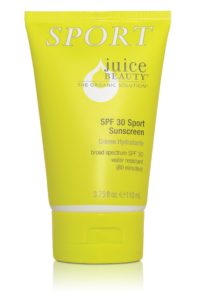
Juice Beauty’s sport sunscreen uses quality organic ingredients–adding a touch of luxury–with a nice price point. My favorite part about this formula is that it is non-drying, blends and absorbs well, and lacks the white pasty residue. Their formula won’t sweat off easily even though it uses a rich moisturizing blend of organic coconut, organic jojoba and soothing aloe with antioxidants and vitamins C and E. Its natural scent is light, fresh and earthy.
Price: $16 (3.75 fl oz); EWG: 1
2. Best Sport Sunscreen: COOLA Suncare Sport Mineral Sunscreen Stick, SPF 50
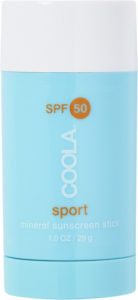
COOLA’s sport sunscreen stick made the cut as it provides excellent sun protection for active folks with very dry skin. This product is ideal to use in deserts or dry mountain environments. It won’t dry out your skin and it stays on. It’s enriched with reparative Sea Kelp Extract, moisturizing Coconut and Avocado Oil, and antioxidant rich Vitamin E—which is over 70% organic. COOLA sport sunscreen has cookie dough scent on application and glides on easily, which will leave a moist glow on your skin. The finish can be slightly tacky, however it leaves no white cast. The matte tint version of this sunscreen is also a great option—it appears very natural. The price point of COOLA’s sport sunscreen stick is higher than most sunscreens. Note: Although COOLA’s sport stick is chemical-free and has a perfect EWG score, be mindful of two toxic ingredients this brand uses in their other luxuriously scented sunscreens—Fragrance and Octinoxate (for enhanced skin absorption).
Price: $26.00 (1 oz); EWG: 1
3. Best Sport Sunscreen: Babo Botanicals SPF 30 Clear Zinc Sport Stick Sunscreen (Face)

Babo’s broad sport stick is very gentle for the face, lips, nose, ears and anywhere with extra sensitive skin. Great for babies and very kind to the earth as well! The all-organic stick goes on clear, is non-greasy, lightweight and rubs in well. The hypoallergenic formula contains vitamin-rich, skin-soothing certified organic oils, including jojoba, with a faint summer scent. This handy clear zinc sick fits perfectly in a pocket. If you have extra sensitive skin, stick with Babo’s sport stick!
Price: $ 12.95 (0.6 oz); EWG: 1
4. Best Sport Sunscreen: Badger Sport Sunscreen and Sport Face Stick, SPF 35
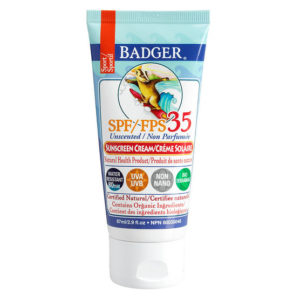
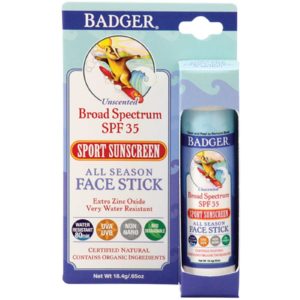
Badger has long been a leader in safe and effective sunscreens. Their hypoallergenic sport sunscreen uses just 5 simple biodegradable ingredients including nourishing organic sunflower oil—with no scents. I consider Badger Sport Sunscreen to be hardier for extreme sports like surfing, kite boarding, skiing and mountain biking. Even though this product is slightly thicker with more of a white sheen than the other recommended sunscreens, this product is ideal to use in intense cold winds and also for swimming in tropical waters with coral reefs. It features the “coral reef safe” certification–and stays on well. The tube is BPA & phthalate-free and made from #2 recyclable plastic. Note: Badger’s Sport Face Stick is equally as good and durable if you are seeking a convenient face stick for your pocket or purse.
Price: $15.99 (2.9 oz); EWG: 1
5. Best Sport Sunscreen: ThinkSport Sunscreen, SPF 50+
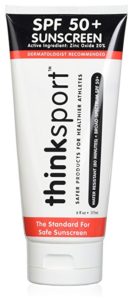
ThinkSport Sunscreen has won a considerable amount of awards for sustainability, effectiveness and safeness. Of all the sunscreens it has the best price point. My favorite feature of this product is that it rubs in very well, its non-scented and moisturizing. Its surprisingly lightweight and stays on. ThinkSport uses silicones for smoothness in application. Although this is non-toxic ingredient, some critics feel silicones can compromise your skin’s ability to breathe. I use this product on a weekly basis, and I have not experienced any such reaction.
Price: $12.99 (3 oz); EWG: 1